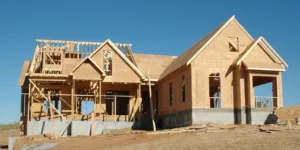Planning to build your dream home? You may already know what you want the house to look like, but do you know where the house will be built?
Choosing a plot of land to build on is just as important as choosing the plans for your new home. If you’ve yet to find your dream location, here are five tips to help you find the right lot for your castle.
1. Check the 4 S’s: Slope, Soil, Sun and Sewer
When choosing a home site, there are four essential things to consider:
Slope
Slope is a key thing to look at when analyzing plots of land. A home placed on a slope will cost more to build than a home placed on flat land. Sloped properties typically offer superior views, but if there’s no flat top to build on, the cost of site preparation can be especially high.
You may or may not have the option to build at the bottom or top of the slope. If you don’t, you can expect to spend more to build your home.
Soil
Soil conditions will also affect the cost of construction. While you can find out a lot of information about the characteristics of the soil on potential sites, you can’t possibly know everything. Make sure to set aside some extra cash to deal with any surprise issues after the contractors start digging.
Most cities require home builders to show the building department that the home’s foundation type is designed for the property’s soil conditions. For this reason, you’ll want to find out as much has you can about the soil.
Sun
Consider the position of the lot and where your home may be placed. A south-facing lot will allow you to take the most advantage of natural sunlight in key areas of your home, like the living room and kitchen.
Building on a lot that gets good sunlight will also help reduce your energy costs, as the sun will provide natural heat.
Sewer
Consider whether the lot has a sanitary sewer line. If you’re looking at undeveloped lots (without any utilities), you will have to pay for private sanitation. That typically means installing a septic tank on the property.
The cost of a private sanitation system is usually much higher than connecting to a public sewer line, so keep this in mind when searching for lots.
2. Go with a Ready-to-Build Lot
If you’d rather not deal with the hassle of running utilities to the property, consider a ready-to-build lot. These plots of land already have electricity, sewer, water and cable lines. All you have to do is build and connect.
In many cases, these lots are also cleared, so you don’t have to worry about removing trees and other expensive site work.
Choosing a plot in a development also has its benefits. The Northern Arizona homes for sale at Foxboro Estates provides access to a club house and will take care of the building for you.
If privacy and freedom are your primary concerns, you may not want to have to deal with homeowners’ associations. In this case, you may have to go through the hassle and expense of buying an undeveloped lot that needs extensive preparation.
3. Consider Lot Preparation
Site work needs to be considered when looking at any plot of land for your home. You might find a great deal on acreage, but if it’s on the side of a mountain and heavily treed, you’ll spend a lot of money preparing the site for building.
If you get lucky enough to find a relatively flat property that’s close to a public road, there may not be much site work needed.
4. Know the Neighborhood
Location is the key most important thing when choosing a plot of land to build on. Get to know the neighborhood and the surrounding area. Drive through at different times of the day to see what the noise and activity level is like. The area may be quiet in the early morning, but loud and hectic in the evening hours.
No matter how perfect the lot is, you need to enjoy where you’re living. Make sure that you really love the area before you make the decision to buy and start building. Changing your mind would be a very expensive decision.
5. Consider Utilities and Easement
Finally, you want to consider utilities and easement. Does the property already have electricity, water, sewer and cable? If not, you will have to pay to run the lines. In some cases, the cost is minimal. But if you have to run the line a long distance, the costs can skyrocket to $10,000 or more.








